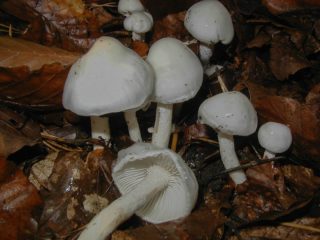Content
Golden hygrophorus is a lamellar mushroom of the Hygrophoraceae family. This species grows in small groups, forming mycorrhizae with different trees. In other sources it can be found under the name golden-toothed hygrophorus. In scientific circles it is listed as Hygrophorus chrysodon.
What does golden hygrophorus look like?
The fruiting body of this species is of the classical type. The cap initially has a convex bell-shaped shape with a concave downward edge. As it matures, it straightens out, but a small tubercle remains in the center. The surface is smooth, sticky, covered with thin scales closer to the edge. In young specimens, the color of the upper part is whitish, but later it becomes golden yellow.The diameter of the cap reaches from 2 to 6 cm.
The pulp is watery and soft. It is characterized by a light shade and does not change when cut. The smell is weak, neutral.
On the reverse side of the cap there are sparse wide plates descending onto the stem. The hymenophore initially has a whitish tint, and then becomes yellow. Golden hygrophorus has white ellipsoidal spores with a smooth surface. Their size is 7.5-11 x 3.5-4.5 microns.
The leg is cylindrical, narrowed at the base, sometimes slightly curved. Its length reaches 5-6 cm, and its width is 1-2 cm. In young fruits it is dense, and then a cavity appears. The surface is sticky, white, with light fluff closer to the cap and yellow scales along the entire length.
Where does golden hygrophorus grow?
This mushroom is common, but grows singly or in small groups. Prefers conifers and deciduous forests with humus-rich soil. Forms mycorrhiza with oaks, lindens, and pine. The fruiting period begins in mid-August and continues until the second ten days of October.
Golden hygrophorus is widespread in Europe and North America. It is found everywhere in Russia.
Is it possible to eat golden hygrophorus?
This mushroom is considered edible. But it does not have high taste qualities, therefore it belongs to the fourth category.
False doubles
Golden hygrophorus at the initial stage of development is in many ways similar to its relatives. Therefore, in order to avoid mistakes, you need to study the characteristic differences between twins.
Similar types:
- Fragrant hygrophor. It has a distinct almond smell, and in rainy weather it can spread several meters around. You can also distinguish it by the gray-yellow shade of the cap. This mushroom is considered conditionally edible and is characterized by a sweetish taste of the pulp. The official name is Hygrophorus agathosmus.
- Hygrophor yellowish-white. The fruit body is medium in size. The main color is white. A distinctive feature is that when rubbed on the fingers, wax is felt. The mushroom is edible, its official name is Hygrophorus eburneus.
Rules for collection and use
Mushroom picking should be done using a sharp knife, cutting off the fruiting body at the base. This will prevent damage to the mycelium.
Before consumption, forest fruits must be cleared of litter and soil particles. After this, rinse the mushrooms thoroughly. Can be consumed fresh or processed.
Conclusion
Golden hygrophorus belongs to the category of unpopular, but edible mushrooms. This is explained by its poor fruiting, which makes harvesting difficult, and its neutral taste. Therefore, most mushroom pickers avoid it. Since during the fruiting period more valuable species can be harvested.











